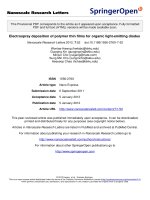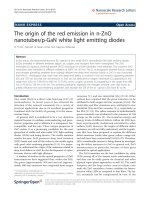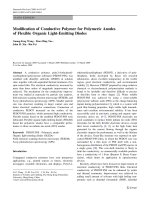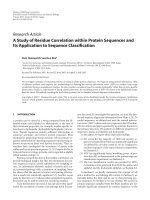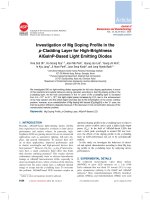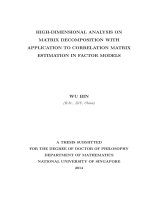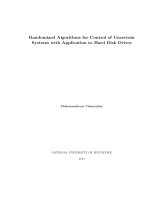Study of drop on demand inkjet printing technology with application to organic light emitting diodes
Bạn đang xem bản rút gọn của tài liệu. Xem và tải ngay bản đầy đủ của tài liệu tại đây (4.56 MB, 257 trang )
STUDY OF DROP-ON-DEMAND INKJET
PRINTING TECHNOLOGY WITH APPLICATION
TO ORGANIC LIGHT-EMITTING DIODES
ZHOU JINXIN
(M.Eng., B.Eng.)
A THESIS SUBMITTED
FOR THE DEGREE OF DOCTOR OF PHILOSOPHY
DEPARTMENT OF MECHANICAL ENGINEERING
NATIONAL UNIVERSITY OF SINGAPORE
2010
Acknowledgements
I
ACKNOWLEDGEMENTS
There are really quite a few persons that have assisted in the realization of my Ph.D.
thesis work. First of all, I send my deep appreciation to my supervisors, Prof. Jerry
Fuh Ying Hsi and A/Prof. Loh Han Tong, for their valuable guidance, scientific advice
and strong encouragement throughout the entire duration of my research. This Ph.D.
degree and dissertation would not have been possible without their generous support
during the most critical stage of my doctoral program. A special thanks goes to Prof.
Wong Yoke San for his valuable comments and suggestions which helped improving
the advancement of my research. Your ideas and our discussions have been very
inspiring. Thanks for your time and encouraging input.
I would like to thank Prof. Chua Soo Jin for his contribution and support from IMRE
on my research. I would also like to thank Mr. Jeffrey Gray for his technical advice
and assistance from IMRE. I am thankful to Dr. William Birch in IMRE for providing
me with the useful knowledge on surface science and the related measurements.
Thanks to all the people in the CIPMAS Lab, especially Mr. Ng Yuan Song who was
my junior project team member, for their making me feel welcome, for their useful
discussions and writings on the research, and for their entertaining conversations over
coffee. Finally I am grateful to my family and close friends for their blessings and
moral support to give me courage and patience to face the obstacles in life.
Table of Contents
II
TABLE OF CONTENTS
ACKNOWLEDGEMENTS I
TABLE OF CONTENTS II
SUMMARY VII
LIST OF TABLES IX
LIST OF FIGURES XI
CHAPTER 1
INTRODUCTION 1
1.1 Background 1
1.2 Research Motivation 4
1.3 Research Objectives and Scope 6
1.4 Organization of Thesis 8
CHAPTER 2
LITERATURE REVIEW 9
2.1 Introduction 9
2.2 OLED Structure and Operation 11
2.2.1 Single Layer Devices 11
2.2.2 Multiple Layer Devices 14
2.3 Materials Used in OLEDs 17
Table of Contents
III
2.3.1 Conjugated Small Organic Molecules 18
2.3.2 Conducive Conjugated Polymers 22
2.3.3 Conducting Polymer - PEDOT:PSS 27
2.3.4 Electrodes - Anode and Cathode 30
2.4 Fabrication Techniques 32
2.4.1 Thermal Vacuum Evaporation 33
2.4.2 Spin-Coating 35
2.4.3 Doctor Blade Coating 36
2.4.4 Screen Printing 37
2.4.5 Inkjet Printing 39
CHAPTER 3
INDIUM-TIN-OXIDE (ITO) SUBSTRATE SURFACE
TREATM ENT
52
3.1 Introduction 52
3.1.1 Introduction to Surface Wettability 53
3.1.2 Review of Surface Treatment and Related Wettability 60
3.2 Experimental Procedures 63
3.2.1 Equipment and Materials 63
3.2.2 Surface Modification of ITO Substrates 65
3.2.3 Contact Angle Measurement Procedures 68
3.3 Results and Discussion 73
Table of Contents
IV
3.3.1 Contact Angles and Surface Energies of Modified ITO Substrates 73
3.3.2 Contact Angle Hysteresis of Modified ITO Substrates 79
3.3.3 Ageing Effect of Modified ITO Surface Wettability 81
3.4 Conclusion 83
CHAPTER 4
INKJET PRINTING: FABRICATION AND
CHARACTERIZATION OF OLEDS
85
4.1 Introduction 85
4.2 Experimental Procedures 87
4.2.1 ITO Substrate Surface Preparation Process 87
4.2.2 Drop-on-Demand Inkjet Printing of PEDOT:PSS 100
4.2.3 Design and Fabrication of P-OLED Devices 109
4.3 Results and Discussion 118
4.3.1 ITO Surface Patterning 118
4.3.2 Drop-on-Demand Inkjet Printing of PEDOT:PSS 119
4.3.3 Characterization of P-OLED Devices 127
4.4 Conclusion 135
CHAPTER 5
CHARACTERIZATION OF SINGLE MICRODROPLET DRYING
BEHAVIOR
138
Table of Contents
V
5.1 Introduction 138
5.2 Overview of Drop Spreading and Drying 139
5.2.1 Drop Impact and Spreading 139
5.2.2 Drop Drying Behavior 141
5.3 Experimental 149
5.3.1 Equipment 149
5.3.2 Materials 149
5.4 Results and Discussion 150
5.4.1 Profile of Printed Droplets after Drying 150
5.4.2 Variations of Drop Profile Properties with Substrate Temperature 159
5.4.3 Drop Dispensing 163
5.5 Conclusion 167
CHAPTER 6
REPRESENTATION AND MAPPING OF DRIED DROPLET
PROFILES
169
6.1 Introduction 169
6.2 Model of Radial Basis Function Networks 170
6.2.1 Basic Theory 170
6.2.2 Training of Radial Basis Function Networks 174
6.3 Normalization of Experimental Data 177
6.4 Results and Discussion 181
Table of Contents
VI
6.4.1 Representation and Mapping of Dried Droplet Profiles 182
6.4.2 Evaluation of Generated RBFN Models 188
6.5 Conclusion 195
CHAPTER 7
CONCLUSIONS AND FUTURE WORK
196
7.1 Conclusions 196
7.2 Future Work 201
BIBLIOGRAPHY 205
PUBLICATIONS 229
APPENDIX A.1
A. Taguchi Design of Experiments in Optimization of Inkjet Printing Drop
Ejection Parameters A.1
Summary
VII
SUMMARY
This thesis aims to further investigate the application of drop-on-demand (DoD) inkjet
printing technology in the fabrication of organic light-emitting diode (OLED) devices.
Three areas of work related to OLED and inkjet printing were performed and
addressed as follows.
Firstly, surface wettability and surface degradation of indium-tin-oxide (ITO) glass
substrates for OLED devices have been characterized by contact angle measurements
after five different surface treatments - two dry treatments (UV-Ozone and
Oxygen-Plasma) and three wet treatments (Alkaline, Neutral and Organic). It is found
that dry surface treatments are generally more efficient than wet surface treatments for
removing hydrocarbon contamination with positive surface modification. Furthermore,
Oxygen-Plasma dry treatment possesses slower surface degradation than UV-Ozone
dry treatment. The results achieved better the existing results reported by other
researchers.
Secondly, polymeric OLED (P-OLED) devices with a hole transport layer of
conductive polymer poly(3,4-ethylenedioxythiophene):poly(styrenesulfonate)
(PEDOT:PSS) at two inkjet printing resolutions have been fabricated in comparison
with the P-OLED of spin-coated PEDOT:PSS layer. Inkjet printing demonstrates to be
able to achieve better P-OLED device performance than spin-coating under some
Summary
VIII
controlled conditions, as it is found that more effective surface contact areas of inkjet
printed functional film exist in between adjacent layers, which may balance and
enhance interactions between the hole and electron charge carriers to improve the
performance of final devices.
Thirdly, in-depth study on characteristics of inkjet printed droplet features after drying
have been conducted from the two aspects of experiment and modeling. The
experiment work makes significant findings on the influence of substrate temperature
on the drying shape of single printed droplets, which are Gaussian shape, transition
shape, and ring-like shape corresponding to different drying temperature range. The
results also imply that the droplet morphology can be controlled for the selected drop
dispensing by the substrate temperature. The modeling work deals with the shape
representation and mapping of dried droplets to drying temperatures. Radial basis
function network (RBFN) is the first to be employed to map the droplet shape. It
evaluates both Gaussian and thin-plate spline (TPS) RBFN methods. It concludes that
the former works well only for a lower temperature range less than 50°C, and the
latter shows a better mapping and estimation across the entire range of drying
temperature. With the successful shape representation and mapping, it would enable
future researches to set desirable drop printing parameters for the required droplet
shape that forms in practice.
List of Tables
IX
LIST OF TABLES
Table 3.1: Sources of thermodynamic contact angle hysteresis. 58
Table 3.2: Summary of contact angles reported from the literature. 62
Table 3.3: Summary of the average sessile contact angles and surface energies. 75
Table 3.4: Summary of the average advancing contact angles. 76
Table 3.5: Summary of the average receding contact angles. 76
Table 3.6: Summary of contact angle hysteresis. 80
Table 4.1: Parameter setting for the Oxygen-Plasma treatment. 98
Table 4.2: Brief specifications for Litrex 80.L inkjet printing system performance. 101
Table 4.3: Brief specifications of Spectra SX3 print-head. 103
Table 4.4: Brief characteristics of PEDOT:PSS (Baytron® P VP CH 8000). 105
Table 4.5: Parameters for voltage pulse profile used in printing PEDOT:PSS. 107
Table 4.6: Parameters for the thermal evaporation system Edwards Auto 306. 114
Table 4.7: Brief information of the P-OLED device performances. 131
Table 5.1: Brief characteristics of PEDOT:PSS (Baytron® P VP CH 8000). 150
Table 6.1: Summary of dried droplet profiles with temperature used for training RBFN.
179
Table 6.2: Summary of dried droplet profiles with temperature used for evaluating
RBFN. 180
Table 6.3: Characteristics and comparison of Gaussian and TPS RBFN training. 186
Table 6.4: Procedure for estimation of dried droplet profile at given temperature. 189
List of Tables
X
Table 6.5: Characteristics and comparison of Gaussian and TPS RBFN estimation. 191
Table 6.6: Procedure for estimation of temperature at given dried droplet profile. 193
Table 6.7: Characteristics and comparison of Gaussian and TPS RBFN estimation. 194
Table A.1: L16(2
15
) array used for Taguchi design of experiments. A.4
Table A.2: Level settings of the main factors for Taguchi design of experiments. A.4
Table A.3: Taguchi design of experiments with 3 replications and randomization. A.6
List of Figures
XI
LIST OF FIGURES
Figure 2.1: Examples of OLED displays in consumer products. 10
Figure 2.2: Basic structure of a single layer OLED. 12
Figure 2.3: Working principle of an OLED device. 12
Figure 2.4: An actual example for the single layer OLED device. 14
Figure 2.5: A multiple layer OLED device. 16
Figure 2.6: Schematic of one more complex OLED device. 16
Figure 2.7: Molecular structure of copper phthalocyanine (CuPc). 19
Figure 2.8: Molecular structures of HTL materials:
N,N'-bis(3-methylphenyl)-N,N'-diphenyl-benzidine (TPD, T
g
= 63°C) and
N,N'-di(naphthalen-1-yl)-N,N'-diphenyl-benzidine (NPB, T
g
= 98°C). 20
Figure 2.9: Small molecular guest dye emitter: 5,6,11,12-tetraphenylnaphthacene
(Rubrene). 20
Figure 2.10: Molecular structure of tris(8-hydroxyquinolinato) aluminum (Alq
3
, T
g
=
174°C). 21
Figure 2.11: Overview of some applications of conductive conjugated polymers. 22
Figure 2.12: Chemical structures of some most essential conductive conjugated
polymers: polyacetylene (PA), poly(p-phenylene) (PPP), poly(p-phenylene vinylene)
(PPV), polythiophene (PT), polypyrrole (PPy), and polyaniline (PANI). 24
Figure 2.13: Main chemical structure of the conducting polymer polyaniline (PANI).
26
List of Figures
XII
Figure 2.14: Molecular structure of PEDOT:PSS. 27
Figure 2.15: Molecular structures of glycerol (boiling point = 290°C), sorbitol (boiling
point = 295°C), and N-methyl-2-pyrrolidone (NMP, boiling point = 202°C). 29
Figure 2.16: Principle of organic small molecules deposition by thermal vacuum
evaporation. 33
Figure 2.17: Schematic representation of doctor blade coating. 36
Figure 2.18: A schematic of typical process for screen printing. The screen is patterned
using a photo emulsion.
37
Figure 2.19: Layout of the different inkjet printing technologies. 40
Figure 2.20: Binary deflection C-IJP system. 41
Figure 2.21: Multiple deflection C-IJP system. 41
Figure 2.22: Streams of continuous droplets from a C-IJP process. 42
Figure 2.23: Schematic of the DoD-IJP process. 43
Figure 2.24: Droplets from a DoD-IJP process. 43
Figure 2.25: Roof-shooter thermal inkjet mechanism layout. 44
Figure 2.26: Side-shooter thermal inkjet mechanism layout. 44
Figure 2.27: Drop formation within the ink chamber of a thermal inkjet device. 45
Figure 2.28: Different modes that a piezoelectric plate can deform. 46
Figure 2.29: Bend mode piezoelectric inkjet system. 46
Figure 2.30: Push mode piezoelectric inkjet system. 47
Figure 2.31: Shear mode piezoelectric inkjet system. 47
Figure 2.32: Squeeze mode inkjet using a piezo-ceramic cylinder and a glass tube. 48
List of Figures
XIII
Figure 3.1: Different surface energy components and contact angle of a liquid droplet.
55
Figure 3.2: Advancing contact angle (θ
a
) and receding contact angle (θ
r
) of a liquid
droplet on a tilted substrate. 56
Figure 3.3: Set-up of the goniometer showing the drop deposited onto the sample on the
sample stage. 68
Figure 3.4: Sample and sample stage. 68
Figure 3.5: Syringe and plunger system used to deposit the one micro-liter droplet onto
the sample.
68
Figure 3.6: Software screen view of a projected sessile drop use for the measurement of
sessile contact angles. 70
Figure 3.7: Software screen view showing the cross-hair that is used to target the sessile
drop for measurement and the tangents for measuring the angle at both ends of the drop.
70
Figure 3.8: Entire goniometer set-up is tilted with the sample, in order to capture
images for the measurement of advancing and receding contact angles.
71
Figure 3.9: As the entire goniometer set-up including the camera tilts together with the
sample, it is able to capture the projected image of a tilted drop and measure it the same
way as an un-tilted sessile drop. The left-end of the droplet gives the advancing contact
angles and the right-end of the droplet gives the receding contact angles. 71
Figure 3.10: Graphical representation of the various sessile contact angles and surface
energies for different surface treatment processes.
75
List of Figures
XIV
Figure 3.11: Summary of all three types of contact angles in the relative positions for
different surface treatment processes. 77
Figure 3.12: Summary of a qualitative variation of contact angles for different surface
treatment processes. 77
Figure 3.13: Ageing effect of UV-Ozone treated ITO surface wettability. 81
Figure 3.14: Ageing effect of Oxygen-Plasma treated ITO surface wettability. 82
Figure 3.15: Contact angle variation on Oxygen-Plasma freshly-treated ITO surface.
83
Figure 4.1: Basic P-OLED device structure being investigated in this research. 86
Figure 4.2: Flow chart of the entire ITO surface preparation process. 88
Figure 4.3: Spin-coater (Model: CEE 100). 88
Figure 4.4: Hotplate (Model: HP-150). 89
Figure 4.5: Karl Suss Mask & Bond Aligner MA8/BA6. 89
Figure 4.6: Trion Sirus reactive ion etching (RIE) system. 90
Figure 4.7: Olympus BX60 metallurgical microscope. 90
Figure 4.8: KLA-Tencor Surface Profiler P-10. 91
Figure 4.9: Spin speed curve used in the spin-coating of photoresist AZ 5214-E. 93
Figure 4.10: (a) Shadow-mask used for UV curing of samples (100×100mm
2
) in the
photolithography process; (b) Top view of a 25×25mm
2
ITO substrate after patterned,
and the black strips are where the ITO remains. 95
Figure 4.11: Summary of processes and parameters for ITO surface preparation. 99
Figure 4.12: Litrex 80.L drop-on-demand (DoD) inkjet printing system. 100
List of Figures
XV
Figure 4.13: Gantry arm holding the print-head assembly. 100
Figure 4.14: Mounted print-head assembly. 100
Figure 4.15: Print-head assembly. 100
Figure 4.16: Spectra SX3 print-head. 102
Figure 4.17: Profile of voltage pulse signal used to control piezoelectric print-head.
103
Figure 4.18: WYKO NT1100 optical profiling system. 104
Figure 4.19: Microscopic image of consistent printed droplets. 107
Figure 4.20: PEDOT:PSS layer printed on patterned ITO substrate. 108
Figure 4.21: Vacuum oven (VWR 1415M-2). 110
Figure 4.22: Thermal evaporation system (Edwards Auto 306). 110
Figure 4.23: OLED current-voltage-luminance (I-V-L) measurement instrument. 111
Figure 4.24: Spin speed curve used in the spin-coating of MEH-PPV. 112
Figure 4.25: MEH-PPV layer spin-coated on PEDOT:PSS layer. 113
Figure 4.26: Shadow mask for the thermal evaporation. 114
Figure 4.27: Thermal evaporation of LiF, Ca and Ag as the cathode electrode. 115
Figure 4.28: Schematic diagram of the fabrication of a P-OLED device. 117
Figure 4.29: Various locations on a patterned ITO substrate showing reasonably sharp
and clear features under an optical microscope. 119
Figure 4.30: Bitmap images for sample pattern printing on photo paper. 120
Figure 4.31: Photographs for PEDOT:PSS pattern printing on photo paper. 120
Figure 4.32: Optical image of inkjet printed PEDOT:PSS dots on the ITO substrate.
List of Figures
XVI
122
Figure 4.33: 3D image of single drop at room temperature. 122
Figure 4.34: Top-down view and 2D cross-sectional profile at room temperature. 122
Figure 4.35: 3D image and 2D profile of PEDOT:PSS single line printed at 450dpi.
123
Figure 4.36: 3D image and 2D profile of PEDOT:PSS single line printed at 720dpi.
124
Figure 4.37: Schematic of the droplet overlapping for 450dpi. 125
Figure 4.38: Schematic of the droplet overlapping for 720dpi. 126
Figure 4.39: Schematic structure of 4 diodes P-OLED device. 127
Figure 4.40: Pictures of a 4 diodes P-OLED device: (a) ITO side facing downwards;
(b) ITO side facing up with cathode layers on the top. 128
Figure 4.41: Characteristic of current density-voltage for P-OLED devices. 129
Figure 4.42: Characteristic of luminance-voltage for P-OLED devices. 129
Figure 4.43: Characteristic of luminous efficiency-voltage for P-OLED devices. 130
Figure 4.44: Characteristic of luminous power efficiency-voltage for P-OLED devices.
130
Figure 4.45: Schematic of effective surface contact area for inkjet printed films. 134
Figure 5.1: Different stages of the drop spreading process on a substrate. 140
Figure 5.2: ‘Ring’ formation due to outward flow of solute particles to the boundary.
141
Figure 5.3: An increment of evaporation viewed in a drop cross-section. 142
List of Figures
XVII
Figure 5.4: Images of the resulting deposit under three evaporation conditions. 143
Figure 5.5: Effect of drying condition on thickness and luminescence of blue
light-emitting polymer films. 148
Figure 5.6: (a) 3D image at 25°C; (b) Top-down view & 2D cross-sectional profile at
25°C. 151
Figure 5.7: (a) 3D image at 30°C; (b) Top-down view & 2D cross-sectional profile at
30°C. 152
Figure 5.8: (a) 3D image at 35°C; (b) Top-down view & 2D cross-sectional profile at
35°C.
152
Figure 5.9: (a) 3D image at 40°C; (b) Top-down view & 2D cross-sectional profile at
40°C. 152
Figure 5.10: (a) 3D image at 45°C; (b) Top-down view & 2D cross-sectional profile at
45°C. 153
Figure 5.11: (a) 3D image at 50°C; (b) Top-down view & 2D cross-sectional profile at
50°C. 153
Figure 5.12: (a) 3D image at 55°C; (b) Top-down view & 2D cross-sectional profile at
55°C.
154
Figure 5.13: (a) 3D image at 60°C; (b) Top-down view & 2D cross-sectional profile at
60°C. 154
Figure 5.14: Summary of the variation of droplet shape with substrate temperature.
155
Figure 5.15: Schematic showing a liquid flow in the evaporation rate distribution theory.
List of Figures
XVIII
156
Figure 5.16: Variation of droplet width with substrate temperature. 159
Figure 5.17: Variation of droplet center height with substrate temperature. 160
Figure 5.18: Variation of droplet edge angle with substrate temperature. 162
Figure 5.19: Linear fittings of the droplet width and height with substrate temperature
after drying in Gaussian Stage. 164
Figure 5.20: Variations of dried droplet properties in Transition Stage: (a) Drops keep
similar height after drying; (b) Droplet width and edge angle vary in the inverse
direction. 165
Figure 5.21: An example of dried single line with sharp edge at 45°C in Transition
Stage: (a) Top-down view; (b) 3D image. 166
Figure 5.22: Linear relation of the droplet width with temperature in Ring-Like Stage.
166
Figure 6.1: Architecture of a generalized radial basis function network. 171
Figure 6.2: Schematic of function profiles for Gaussian and thin-plate spline. 173
Figure 6.3: Plot of all normalized dried droplet Profiles. 181
Figure 6.4: Convergence of EM algorithm for RBFN training from data set T7. 183
Figure 6.5: RMSE of the network with different number of RBFs. 184
Figure 6.6: Shape representation and mapping using both Gaussian and TPS RBFN.
186
Figure 6.7: Shape estimation using both Gaussian and TPS RBFN. 190
Figure A.1: Schematic flow of methodology based on Taguchi design of experiments
List of Figures
XIX
for data collection and analysis. A.3
Chapter 1 Introduction
1
CHAPTER 1
INTRODUCTION
1.1 Background
Using organic materials for light-emitting diodes (LED) is fascinating due to their
vast variety and the relative ease of controlling their composition to tune their
properties through chemical means. Due to the promising attributes of organic
light-emitting diodes (OLED) for applications in flat panel displays, research and
development efforts in the field of plastic electronics are increasing dramatically. The
ease of fabrication, wide-viewing angle, mechanical flexibility, transparency and
excellent scalability are some of the attractive features of such devices. Especially, the
flexible and transparent nature of OLED allows for new applications to emerge, such
as portable electronics, roll-up and see-through displays.
Compared to a liquid crystal display (LCD) used in many computer screens today, one
of the largest benefits of an OLED display is that OLEDs do not require a backlight to
function. They are self-luminous and do not require backlighting, diffusers, polarizer
or any of the other supporting electronics that are commonly used in LCDs
[1-2]
. This
eliminates the need for bulky and environmentally undesirable mercury lamps and
yields a thinner, lighter, more versatile and more compact display. They draw far less
power and can be used with small portable devices. Hence, they will be able to last for
Chapter 1 Introduction
2
a longer period of time with the same amount of battery power. Their low power
consumption provides for maximum efficiency and helps minimize heat and electrical
interference to other electronic devices. However, degradation of OLED working
materials has limited their use
[3]
.
One basic OLED cell structure consists of a few thin organic layers, sandwiched
between two electrode layers. When an external voltage is applied to the cell, the
active organic layer produces visible light. The first OLED was made in 1965 by
Helfrich and Schneider
[4]
using an anthracene crystal. But it was only in 1987, when
Tang and Van Slyke
[5]
in Eastman Kodak Company reported a small molecular
OLED (SM-OLED) consisting of a bi-layer thin film via vapor deposition process, to
achieve a substantial advance towards a practical organic electroluminescence
technology. This is also the rudiment model for present OLEDs. Their work showed
that amorphous or nearly amorphous active materials, through simple fabrication
procedures such as sublimation, were adequate to realize stable devices using small
direct-current (DC) voltages (~10V). These results raised worldwide research interest
in organic materials for LED research. In 1990, the research group Burroughes et al
[6]
in Cambridge University announced conjugated polymer OLEDs (P-OLED), with the
same light emission mechanism but with different two polymers, that successfully
developed a new display technology. Conjugated polymers have an intrinsic
advantage over small organic molecules due to their better mechanical properties,
easy fabrication techniques, flexibility and cost effectiveness. Many renowned
Chapter 1 Introduction
3
companies such as Seiko-Epson, Eastman-Kodak, Cambridge Display Technology
(CDT), Sony, and Samsung are exploring for the possible applications of these
conjugated polymers.
Generally, SM-OLEDs are patterned and produced via vacuum deposition methods.
However, for roll-to-roll based processing, such vacuum deposition methods are
relatively expensive, time consuming, and offer a limited scope of pattern shape and
dimension. In contrast, as conjugated polymer materials used in P-OLEDs are
solution processable, this means that P-OLED devices can be made in a very flexible
and cheap way. In fact, although P-OLED lags SM-OLED development by a few
years, in terms of efficiency and lifetime, it is still more promising because of their
easier production techniques, such as spin-coating (or solution-casting) through
photolithography processes
[7]
, screen printing
[8-9]
and inkjet printing
[7, 10-14]
, which
do not require vacuum environment. Spin-coating is a simple and cost effective
method. However, material wastage is very high and it can normally be used to
produce monochrome displays only. Screen printing technique requires a physical
entity through which a given pattern is transferred to the underlying substrate. This
entity (i.e. stencil for screen printing) must be changed when a new pattern is needed.
Moreover, it relies on contacting the substrate during the printing process, which may
be undesirable in some cases. Among all these polymer deposition techniques, inkjet
printing is potentially the most low-cost and a high throughput approach
[15]
with
maskless and non-contact fabrication advantages.
Chapter 1 Introduction
4
Drop-on-demand (DoD) inkjet printing as a member of inkjet printing family is an
additive manufacturing process which “direct-writes” or dispenses materials directly
onto a substrate to build up a specimen part drop by drop. Over the past decade, this
technology has come to be viewed as a precision micro-dispensing tool, in addition to
its huge success with color printing. It is capable of precise deposition of pico-liter
(pL) volumes at high rates, even onto non-planar surfaces. A high resolution of about
15µm diameter dispensed droplets (~2pL in volume) with high generation rates of up
to 30kHz can be obtained
[16]
. Currently, a variety of materials has been deposited by
DoD inkjet printing including ceramics, metals, organic semiconducting materials,
and biopolymers
[17]
. In the development of OLEDs, drop-on-demand inkjet printing
technology has been used to deposit polymer layers on the top of a given anode
[10-12]
,
or to print poly(3,4-ethylenedioxythiophene):poly(styrenesulfonate) (PEDOT:PSS)
and/or electroluminescent polymers in a pixel array on a circuit
[13-14]
. This promises a
low cost, maskless, and non-contact approach to fabricate potentially delicate features
in a virtually limitless selection of patterns.
1.2 Research Motivation
Since inkjet printing technology was applied in the OLED fabrication, with its
inherent manufacturing advantages, inkjet printing has been becoming the next most
sought-after method for the production of organic electronics. Across the globe, quite
a large number of research institutes and companies involved in the display industry
Chapter 1 Introduction
5
have reported the fabrication of OLED devices by drop-on-demand inkjet printing to
high resolution and large screen sizes. However, any manufacturing details or insights
into the finer points of inkjet printing and relevant operating parameters have still not
been revealed, to say nothing of much less their influence on OLED device
performance. Therefore, in this research, aspects of OLED fabrication using
piezoelectric DoD inkjet printing will be investigated under experiments. In some
areas, statistical analysis will be used to examine experimental results in order to
obtain a better understanding of the behavior of this versatile technique.
Upon impact of an ejected droplet from an inkjet printing machine, surface properties
of the substrate other than impact mechanics of the droplet plays an important role in
the spreading, solidification and dried character of the droplets. Surface characteristics
of OLED substrates are normally modified during the preparation processes. When
the inkjet printed layer is printed onto these substrates, these processes will have an
influence on the droplet as it initially forms on the surface. It will also have an effect
on the interfacial properties between the substrate and the printed layer. These
variations will in turn affect performance of complete P-OLED devices to various
degrees. In this research, some aspects of the substrate preparation process will be
fine tuned and related surface characteristics produced will be also investigated.
Inkjet printing technique requires depositing solutions to have low viscosity
[18]
. A
drying droplet sometimes deposits its solute as a ring stain under some printing

